Last week, over 20,000 custom installers, electronics manufacturers and journalists converged on the Denver Convention Center for CEDIA Expo 2023. Robert Silva and I covered the event for eCoustics this year and I'm happy to report that there are a lot of cool and exciting things happening in the home theater, home audio and video space. Here are some of the standout demos, companies and technology we saw and heard at the show.
While there were a lot of great displays to be seen at CEDIA Expo, the one that stood out most to me for innovation was from Jupiter (the company, not the planet). Jupiter specializes exclusively in 21:9 flat panel displays. The ultrawide 21:9 (2.33:1) aspect ratio makes them ideal for watching movies and episodic TV series which are composed for the CinemaScope screen format. And while you can certainly display 21:9 content on a traditional 16:9 widescreen display, you get those letterbox bars at the top and bottom of the screen which can be distracting.
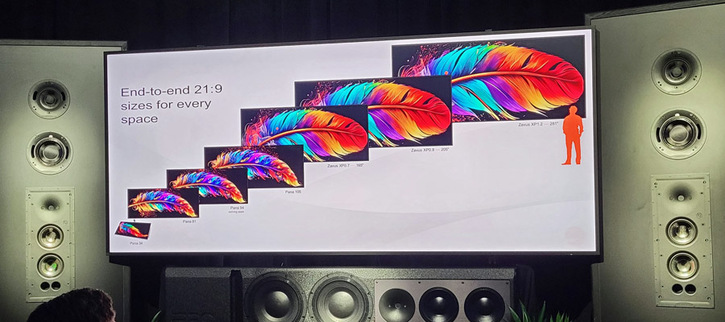
In addition to watching movies, the company stated that they also see customers using their displays for video conferencing and other multi-view purposes (e.g., picture in picture or picture next-to picture). While companies such as LG, Samsung and even Vizio previously dabbled in the 21:9 display market for home use, those models are long obsolete or never came to market and none of the larger TV vendors are currently offering 21:9 aspect ratio screens to consumers in large sizes. While it is possible to create a custom 21:9 display using MicroLED modules or projection-based systems, these generally require more complicated installation as well as much higher price tags.
Jupiter's 21:9 Direct View LED/LCD panels sell for a fairly reasonable $5,000 in the 81-inch diagonal size and $13,000 in the 105-inch version which we saw in person at CEDIA Expo in Theory Audio Design's booth. Jupiter offers 21:9 displays sized from 34 inches up to 281 inches, however, everything above 105 inches uses component-based MicroLED technology, assembled on site in custom sizes.
More Information: Jupiter.com
It's hard to beat OLED (Organic Light Emitting Diode) TVs for picture quality: rich saturated colors pop off a deep inky black backdrop for an almost three dimensional picture without the need for those goofy 3D glasses. And this year's Sony flagship the Bravia XR A95L QD-OLED takes Samsung's latest QD-OLED panel and wraps it in a slick Sony chassis built on Google TV and featuring the latest version of Sony's advanced Cognitive Processor XR. The new QD-OLED panel offers up to twice the peak brightness of last year's model and includes support for Dolby Vision HDR, something that has become more common on streaming services and even Ultra HD Blu-ray Discs.
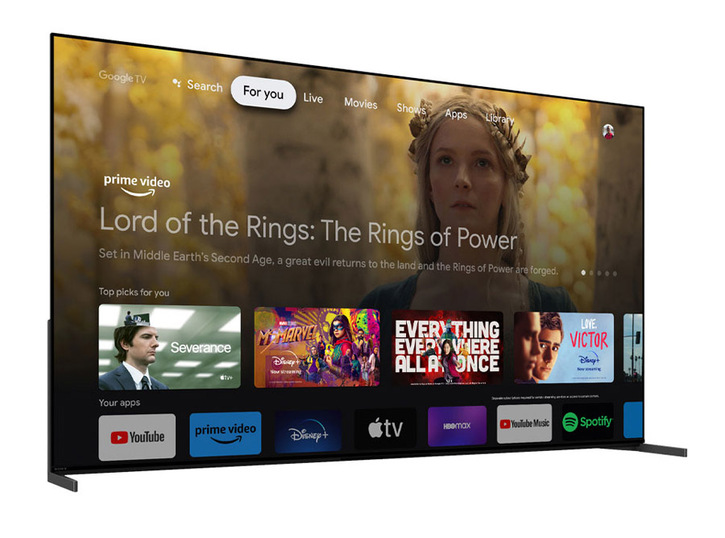
These high-end TVs don't come particularly cheap, though. The 55-inch A95L sells for $2,799, the 65-inch model sells for $3,499, and the 77-incher lists for $4,999. We'll be seeing this one soon up against the competition at the 2023 Value TV Shootout (September 30-October 1). So be sure to check back to see how it fares against this year's top models.
More Information: Sony OLED TV
While TV screens come in all sizes, most of what was on display at CEDIA Expo was on the larger end of the spectrum. The show is primarily for custom installers who are putting in high end home theaters for their clients so the proliferation of ultra large screens at the show makes sense. LG's 97-inch M3 4K Wireless OLED TV stands out for a few reasons. Its large size makes it a viable choice for home theater. Its new Evo OLED panel with ALR technology makes it up to 60% brighter than last year's models and its fully wireless audio/video capability is a first for 4K OLED TVs.
Instead of requiring that you plug your sources directly into the TV, the company provides a separate module to handle all of the hook-ups. LG's "Zero Connect" box accepts network connections, HDMI, USB and analog audio/video connections and transmits the audio and video signals directly to the display. If you're putting this big boy into an open space, it's nice to know that the only cable you'll need to plug in is a power cord. Even the speakers are wireless as the TV includes WiSA on board for wireless speaker connectivity.
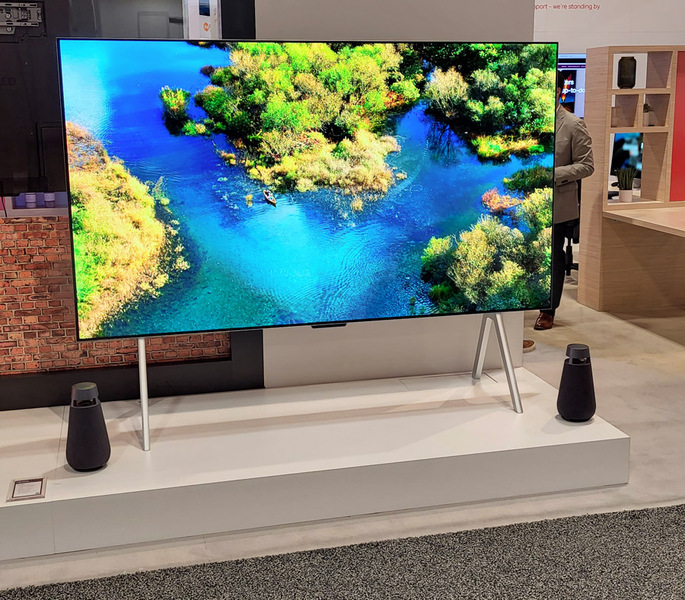
The 97-inch M3 model is pretty pricey at $29,999 but an 83-inch version is available for a more reasonable $7,999. The 77-inch M3 sells for just $4,999 which is only a $500 premium over its otherwise identical wired brother the G3. If you're going to mount this in the wall, I'd say go for the G3 instead as you'll be able to hide the wires, but if a TV in the middle of a wide open floor plan is what you're going for, the M3's single power cable requirement makes for a compelling choice.
More Information: Want a 97-inch Wireless 4K TV? Check out LG's M3 OLED
If your screen size requirements exceed 100 inches, you're going to have to crack open that wallet just a little bit (OK, a lot) wider. Several manufacturers offer projectors that can fill a screen over 100 inches but few are going to give you better results that Barco's Njord CS. With 9,000 Lumens of brightness, the Njord CS was able fo fill 200-inch screens in both the Trinnov and StormAudio home theater rooms at the show. And unlike most projectors, it is optimized for CinemaScope (2.37:1) viewing. It uses three of Texas Instruments large 0.9" DLP chips with pixel shifting to create a full 5K resolution. Fed with high quality 4K HDR content from a Kaleidescape media server, the Njord CS created a big, bright, beautiful image, free of the artifacts we see on many less expensive projectors.
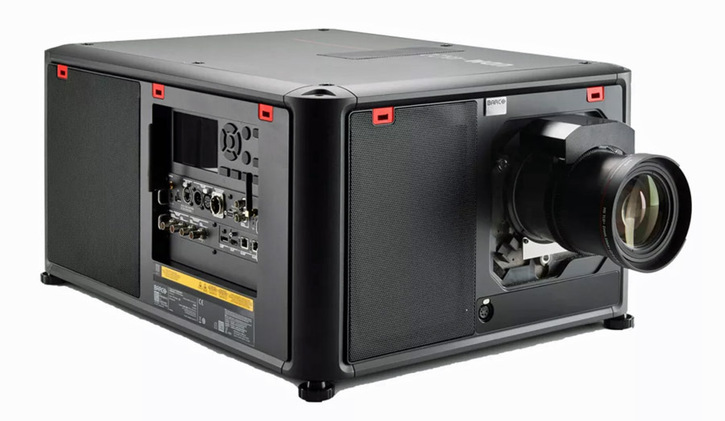
But alas, the best does not come cheap. Barco's Njord CS sells for $164,000. Screen not included. For that we'd suggest models from Seymour Screen Excellence or Stewart Filmscreen. Seymour's Enlightor-Neo matte finish woven screen was used with the Barco projector in both the Trinnov and StormAudio rooms to excellent effect. The screen is made to be acoustically transparent with an ultra-fine weave so you can mount your speakers behind it for transparent sound, without losing any of the picture details.
More Information: Barco Residential Njord CS Projector
As far as "purist" two-channel stereo systems, well there weren't too many of these on display. While there is still a market for 2-channel systems for hard-core audiophiles, the CEDIA show places more emphasis on smart home integration and multi-channel home theater systems as this is where custom installers see the most opportunities. That said, I was surprised that Focal had their Grande Utopia EM EVO four-way flagship speakers set up in the open on the show floor. No booth or barriers around it to keep out the noise. Fortunately we stuck around until the final hours of the show when things were a bit quieter and less hectic on the show floor, so I got to hear this $280,000 pair of speakers powered by the Naim Statement preamp/power amp combination ($300,000). Just lovely balanced sound with three dimensional imaging, excellent deep bass extension and high decibel levels with ultra low distortion thanks to 746 watts/channel.
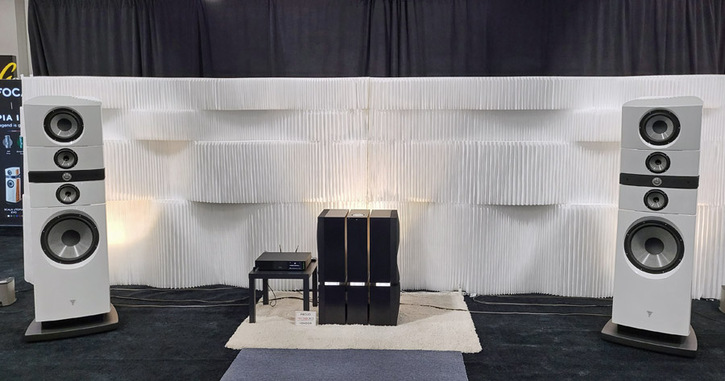
And hey, if you buy this system and your finances take a turn for the worse, you can always trade it for a house.
More Information: Naim Statement, Focal Grande Utopia EM Evo
Continuing on with the "cost no object" systems, Trinnov partnered with Crescendo loudspeakers to demonstrate Trinnov's new "WaveForming" technology. In development for over seven years, WaveForming uses comprehensive sonic measurements, precise subwoofer placement and advanced digital processing to solve one of the "holy grails" of home theater sound: uneven bass response. And this technology was used at CEDIA Expo to create one of the most impressive home theater systems I've ever heard.
In a typical home theater or living room, it is nearly impossible to get uniform low frequency response. Low frequency sound waves like to bounce around the room creating standing waves (where bass is exaggerated) and bass nodes (where bass is low or even non-existent) in different parts of the room. This happens when two low frequency waves overlap and interfere with each other to increase or reduce the presence of bass in different room locations in different frequency ranges. Using WaveForming, one array of subwoofers is placed in the front of the room to "transmit" the bass while a second array is placed in the back of the room to "absorb" the bass. Basically the rear subwoofers are used to cancel out and shape the bass waves and prevent them from propagating all over the room.
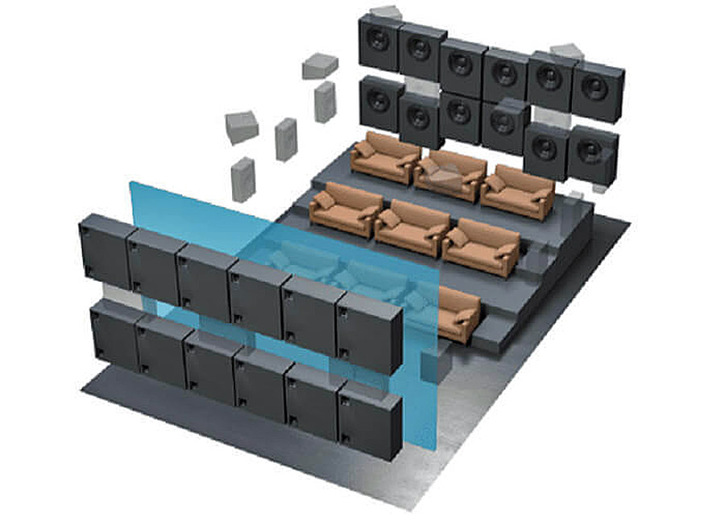
The system that these companies set up was over-the-top: 43 speakers, with 24 subwoofers powered by over 125,000 watts of amplification. The room was custom-built in Italy by Officina Acoustica. The gear was set up in the room in Italy for measurement and calibration then shipped to Denver where it was re-assembled on the show floor in under three days. They didn't slouch in the video department either, with Barco's Njord CS projector lighting up a 189-inch wide Enlightor-Neo screen in a 2.37:1 CinemaScope configuration. MadVR's latest Envy Extreme Mark 2 processor was used for HDR tone-mapping and AI-based motion processing. For source material, the company used Kaleidescape's latest media server with 4K HDR content and Dolby Atmos immersive surround.
While the movie clips were impressive with tight focus, a cohesive dome of three dimensional sound, deep, precise and impactful bass response, it was a much simpler demo that was even more effective. The company played a low bass sweep from 20 Hz to 100 Hz. First, without WaveForming, the bass frequency exhibited the typical problems we hear in home theater systems: peaking in some frequencies, disappearing in others: it was a very bumpy ride. Then they played the same sweep with WaveForming turned on and the sound level stayed just about perfectly consistent through the entire sweep. I sat through the demo a second time and heard the same results in a completely different part of the room. Many companies promise that every seat will be the "best seat in the house" but Trinov Audio appears to be delivering on this promise.
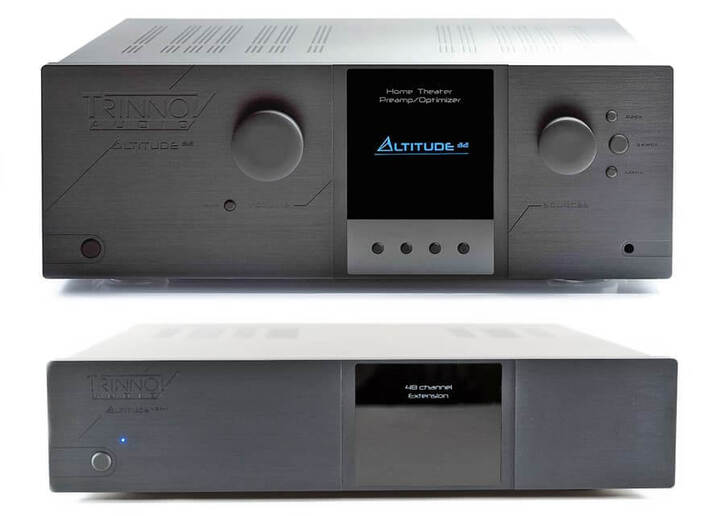
And while 24 subwoofers is a lot to ask (even for one percenters), Trinnov demonstrated that they can get good results with as few as five subwoofers - three in the front, two in the back. The first part of the demo, a scene from "John Wick 4" used just five subs and had impressively even bass response, with deep extension and excellent dynamics. When pressed for pricing of the system, all the exhibitors would say was that it was "well into seven figures," so yeah, well over a million dollars including gear and installation. But for those with the resources, this technology can provide a very special audio and visual experience at home.
More Information: CEDIA Expo's Sickest Demo Includes 43 Speakers, 125,000 Watts and 9,000 Lumens (eCoustics)
If you don't have a few hundred thousand dollars burning a hole in your pocket, don't despair! There are plenty of more affordable options that can provide excellent sound. Case in point: Theory Audio Design's ic6 in-ceiling speaker ($675/each). These versatile point source loudspeakers were the brainchild of legendary speaker designer Paul Hales, who also founded the company. Although they are intended for in-ceiling use, they're also perfectly happy sitting in a wall, in an external cabinet for surface mounting or in a pendant housing, hanging from the ceiling.
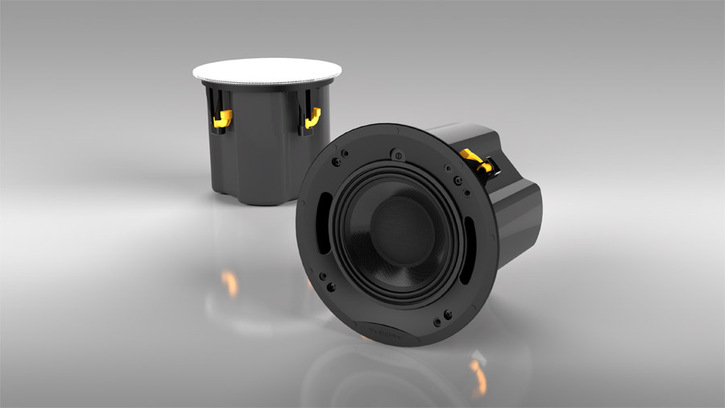
Theory started their CEDIA demo with just a pair of in the ic6 speakers installed into the front wall. These are 9" round speakers with a coax point source driver which features a 6.5" carbon fiber woofer and 1.4" advanced polymer compression driver at the center. When Hales started playing music, we were blown away by the rich dynamic sound. On their own, the bass response doesn't go below about 60 Hz, but the bass that was present was full and precise. Hales showed the same speaker in a pendant design and in cabinets for on-wall or on-ceiling placement. The timbre was the same no matter how it was housed.
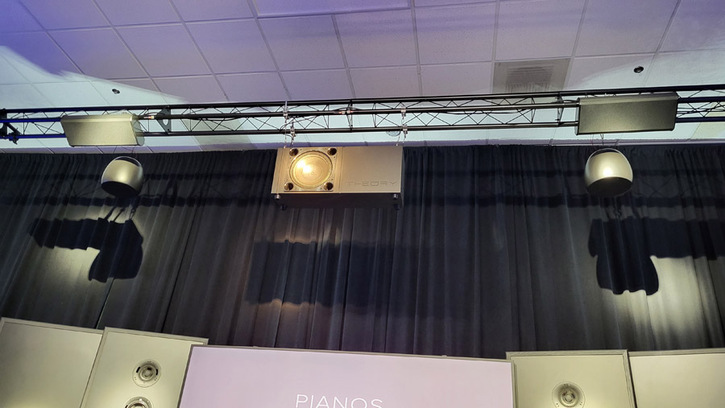
After a while, Hales added one of their subs to the mix and things got really interesting. Instruments and voices just sounded real, piano sounded like a piano, drums had the snap and attack you hear from a live kit, and vocals floated in space with a tangible presence. With the subwoofer added (their new iws12-9 High Output Multi-Mount Sub ($2,050), the bass extended all the way down to about 24 Hz so really nothing was missing. The character of the sound did not change, but the extended bass reponse provided much more heft, impact and weight to the mix.
The only additional consideration is that the Theory speakers are designed to work with Theory's own ALCs (Amplified Loudspeaker Controllers). These are more than just amplifiers, with advanced DSP and processing on board to make each speaker sound its best in its specific location. The Theory DLC-250.4 500W 4-channel amplified loudspeaker controller sells for $1,950 and can drive four independent channels and up to 16 Theory Audio speakers. Its compact design takes up half a standard rack space. Two of these can power a full 5.1.2-channel immersive surround system using seven ic6 speakers in your chosen installation option and one of the company's in-wall subwoofers. Just add your favorite A/V processor or receiver with preamp outputs and you'll be off and running (and rocking and rolling) without having to take out a second mortgage.
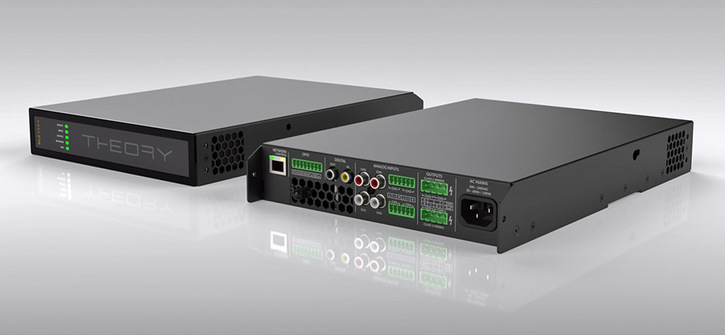
More Information: Theory Audio Design Wows Crowds at CEDIA Expo (eCoustics)
Although CEDIA Expo is all about professional installers and custom home theaters, the show also had vendors, products and technologies that would appeal to A/V hobbyists and general consumers as well. While movie-lovers enjoy immersive surround sound like Dolby Atmos and IMAX immersive sound in theaters, one factor that has limited their adoption at home is the complexity and cost of a multi-channel surround system. Many folks don't want to pay a lot for a surround sound system and don't want to have to deal with running multiple speaker wires all over the room.
While there are several TV makers and speaker makers like Sonos who offer their own proprietary wireless speaker solutions, two companies are making strides in bringing to market new wireless surround sound standards that could be embedded into any TV, soundbar or speaker design. A new wireless multi-channel standard would allow customers to choose a compatible TV from any brand and match that up with a compatible speaker system, also from any brand. The two companies working on these new standards are WiSA Technologies (Wireless Sound and Audio) and DTS with DTS Play-Fi.
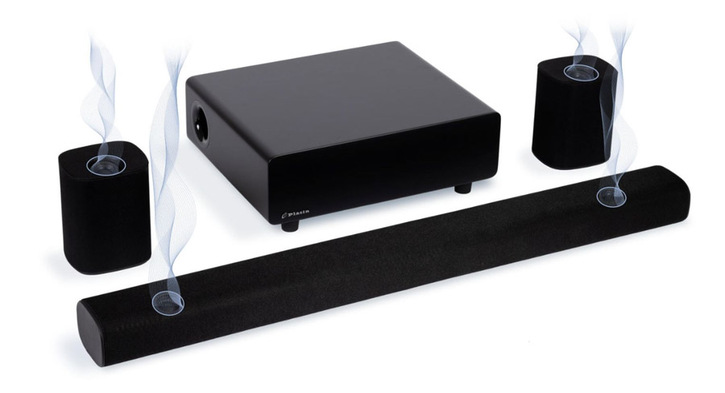
WiSA has been delivering wireless speaker solutions for over a decade and recently expanded into multi-channel surround. WiSA offers three different flavors of wireless multi-channel audio.
WiSA HT (Home Theater) supports up to eight channels of wireless audio (7.1 or 5.1.2 surround). With the help of a wireless dongle, WiSA HT can work with any TV that has an HDMI eARC port. WiSA HT is a audiophile-friendly format with support for multi-channel 24-bit/96 KHz High Res Audio over wireless. It also features extremely low latency which means you shouldn't see any lip synch delays or problems synchronizing speakers in multiple rooms. It is not yet available in TVs, but the SoundSend dongle can be used with just about any modern TV with an HDMI eARC port. This does make installation slightly more complicated than if the transmitter were built into the TV.
WiSA DS (Discrete System) - this is a hybrid wired/wireless system for soundbars which relies on the front channels (front left, center, front right and front height channels) being sent to the soundbar from the TV using an HDMI cable with eARC. The powered soundbar has a WiSA DS transmitter built in which sends the rear surround, rear height and subwoofer channels out to those speakers wirelessly. Since the soundbar is normally placed very close to the TV, the requirement for a wire from TV to soundbar is not too drastic. Using this hybrid system, WiSA DS can support 5.1.4-channel immersive surround (5 surround channels, 1 subwoofer and 4 height channels). The WiSA DS format does not support High Res Audio but it does offer "slightly better than CD quality" sound at 16-bit/48KHz.
WiSA E is the company's latest offering. Like WiSA HT, WiSA E supports up to eight channels currently, but WiSA E can be expanded to more channels over time. And though both WiSA HT and WiSA E currently require the use of WiSA's proprietary transmitter chip, company reps told us that they are working to deliver a software-only solution for WiSA E that will work with any of the commonly used WiFi chips in current TVs. WiSA E also supports High Res Audio but at lower resolution than WiSA HT (24-bit/48KHz).
Meanwhile DTS has their own multi-channel surround format called DTS Play-Fi. At CEDIA Expo, the company announced (and demonstrated) the latest version of Play-Fi "DTS Play-Fi Immersive Home Theater" which now supports up to 12 channels of sound. This gives the DTS Play-Fi format the ability to deliver a full 7.1.4-channel immersive surround sound system, seven ear-level surround speakers, a subwoofer and four height speakers. Technically the system can drive a 7.2.4-channel system, but both of the subwoofers receive the same low frequency signal. 7.1.4 is considered by many home theater pros to be enough channels and speakers to create a seamless immersive surround sound experience even in medium to large living rooms and DIY home theaters. Also, DTS said that their solution is software-only on the TV side, which means it can be ported to multiple TV brands, regardless of their WiFi chipset.
It's important to note that while DTS is the brand behind Play-Fi, DTS Play-Fi is format-agnostic when it comes to immersive surround sound. DTS Play-Fi is perfectly happy reproducing Dolby Atmos or IMAX Enhanced immersive surround. The surround decoder is actually built into the TV, where the Dolby or DTS surround signal is converted into multi-channel PCM sound. This multi-channel PCM signal is then sent wirelessly to all compatible speakers in the room via DTS Play-Fi.
Having spoken at length to executives from both companies, I'm encouraged that both formats seem to be making good progress. But neither format has "arrived" just yet. By that I mean that for either format to succeed, they need partners: TV manufacturers and speaker makers who will license and embed the companies' technologies into their products.
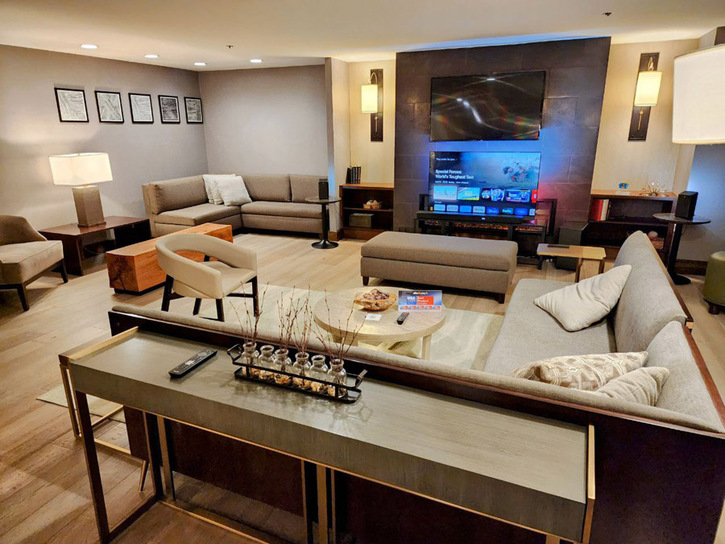
DTS Play-Fi does seem to be a little further along in that they announced that TPV, makers of Philips TVs in Europe will include DTS Play-Fi Immersive Home Theater in select Philips TVs which will come to market within the year. Philips also already has DTS Play-Fi-compatible soundbars and speakers which are available today in both Europe and the United States. The product is far enough along that they were able to give live demos of a full 7.1.4-channel immersive surround sound system and showed us what the DTS Play-Fi user interface and set-up screens look like inside the Philips TV menu. Meanwhile WiSA's speaker partner Platin does have 5.1.2 and 5.1.4 channel immersive speaker systems that support WiSA HT and WiSA DS in production, but support for the multi-channel WiSA formats has not been announced by any TV manufacturers yet.
We're expecting to see additional partnership announcements at CES that might reveal which of these technologies is going to gain market share in wider markets such as the United States. Hopefully by this time next year, there will be more options for simple wireless immersive surround sound that customers can actually buy and set up in their own homes.
Read More Here: WiSA and DTS Play-Fi Bring Wireless Immersive Sound One Step Closer to Reality (eCoustics)
When companies invest tens of thousands of dollars into a trade show, they want to make sure absolutely everything goes as planned. They certainly don't want to have to worry about whether their audio/video sources are going to behave. And if you want to play clips from multiple shows or movies, no one wants to have to swap discs every few minutes and wait to get through those non-skippable menus at the beginning of the movie. For this reason (among others), Kaleidescape was extremely popular at CEDIA Expo 2023. Their media servers and players were used in no less than 42 different booths to provide high quality 4K video and immersive surround sound to show attendees, making sure their exhibiting partners got to show off their gear in the best possible light.
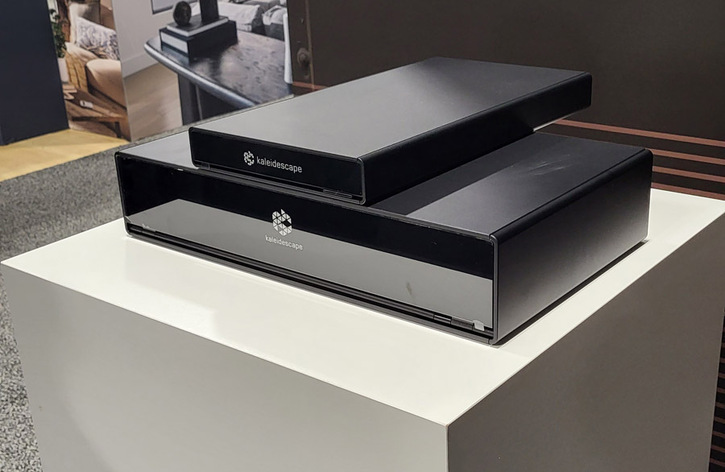
Kaleidescape systems start at about $9,000 for the media player and server. The system combines the convenience of streaming (instant gratification) with the picture and sound quality benefits of physical media. A full 4K movie can be downloaded to one of Kaleidescape's media servers in about eight minutes. And once it has been downloaded, you don't need to worry about slow navigation or buffering. While Kaleidescape may be out of reach to most consumers, it's what you'll find in many high-end home theaters, whether those be in a penthouse in Manhattan, the Hollywood mansion of an A-List director or actor or the mega-yacht of your friendly local billionaire.
More info: Kaleidescape.com
CEDIA Expo 2023 had much to offer attendees, with a wealth of advanced products, technologies and service offerings for the home theater and smart home custom installation professional. The show will be back in Denver next year and we're planning to be there to cover it.
Related Reading: